Menu Planning and Product Development Assignment PDF
VerifiedAdded on 2021/01/02
|8
|2308
|80
AI Summary
Contribute Materials
Your contribution can guide someone’s learning journey. Share your
documents today.
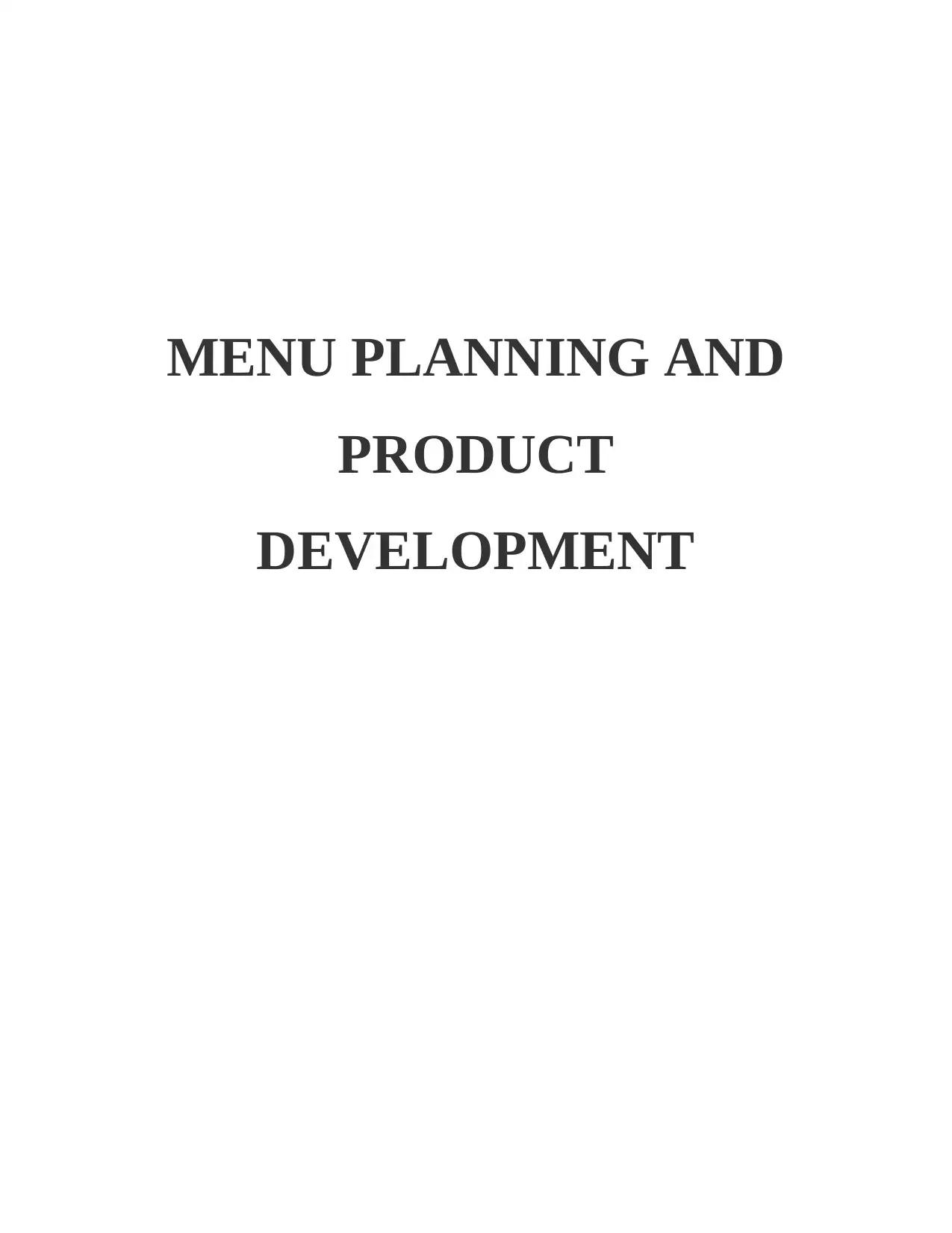
MENU PLANNING AND
PRODUCT
DEVELOPMENT
PRODUCT
DEVELOPMENT
Secure Best Marks with AI Grader
Need help grading? Try our AI Grader for instant feedback on your assignments.
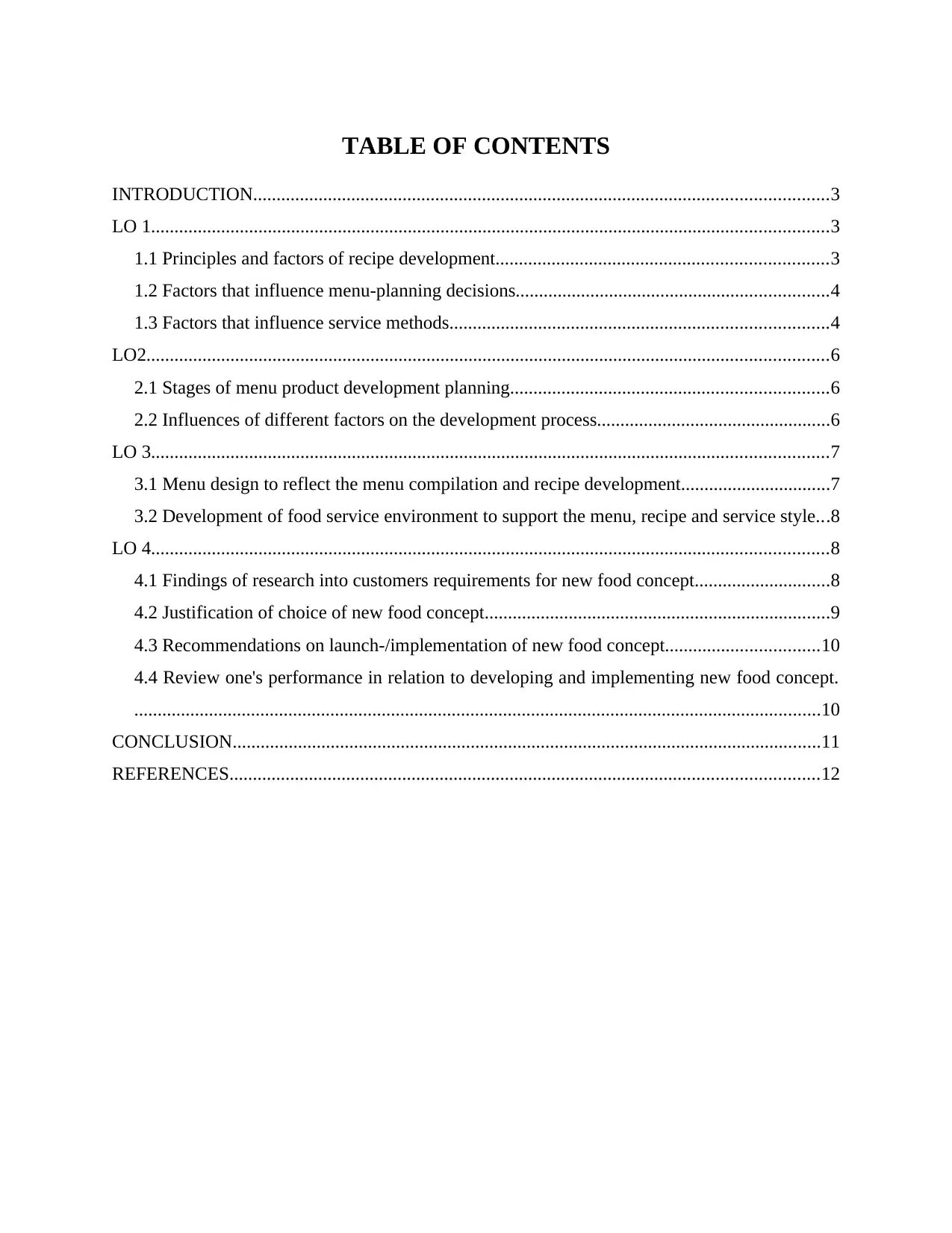
TABLE OF CONTENTS
INTRODUCTION...........................................................................................................................3
LO 1.................................................................................................................................................3
1.1 Principles and factors of recipe development.......................................................................3
1.2 Factors that influence menu-planning decisions...................................................................4
1.3 Factors that influence service methods.................................................................................4
LO2..................................................................................................................................................6
2.1 Stages of menu product development planning....................................................................6
2.2 Influences of different factors on the development process..................................................6
LO 3.................................................................................................................................................7
3.1 Menu design to reflect the menu compilation and recipe development................................7
3.2 Development of food service environment to support the menu, recipe and service style...8
LO 4.................................................................................................................................................8
4.1 Findings of research into customers requirements for new food concept.............................8
4.2 Justification of choice of new food concept..........................................................................9
4.3 Recommendations on launch-/implementation of new food concept.................................10
4.4 Review one's performance in relation to developing and implementing new food concept.
...................................................................................................................................................10
CONCLUSION..............................................................................................................................11
REFERENCES..............................................................................................................................12
INTRODUCTION...........................................................................................................................3
LO 1.................................................................................................................................................3
1.1 Principles and factors of recipe development.......................................................................3
1.2 Factors that influence menu-planning decisions...................................................................4
1.3 Factors that influence service methods.................................................................................4
LO2..................................................................................................................................................6
2.1 Stages of menu product development planning....................................................................6
2.2 Influences of different factors on the development process..................................................6
LO 3.................................................................................................................................................7
3.1 Menu design to reflect the menu compilation and recipe development................................7
3.2 Development of food service environment to support the menu, recipe and service style...8
LO 4.................................................................................................................................................8
4.1 Findings of research into customers requirements for new food concept.............................8
4.2 Justification of choice of new food concept..........................................................................9
4.3 Recommendations on launch-/implementation of new food concept.................................10
4.4 Review one's performance in relation to developing and implementing new food concept.
...................................................................................................................................................10
CONCLUSION..............................................................................................................................11
REFERENCES..............................................................................................................................12
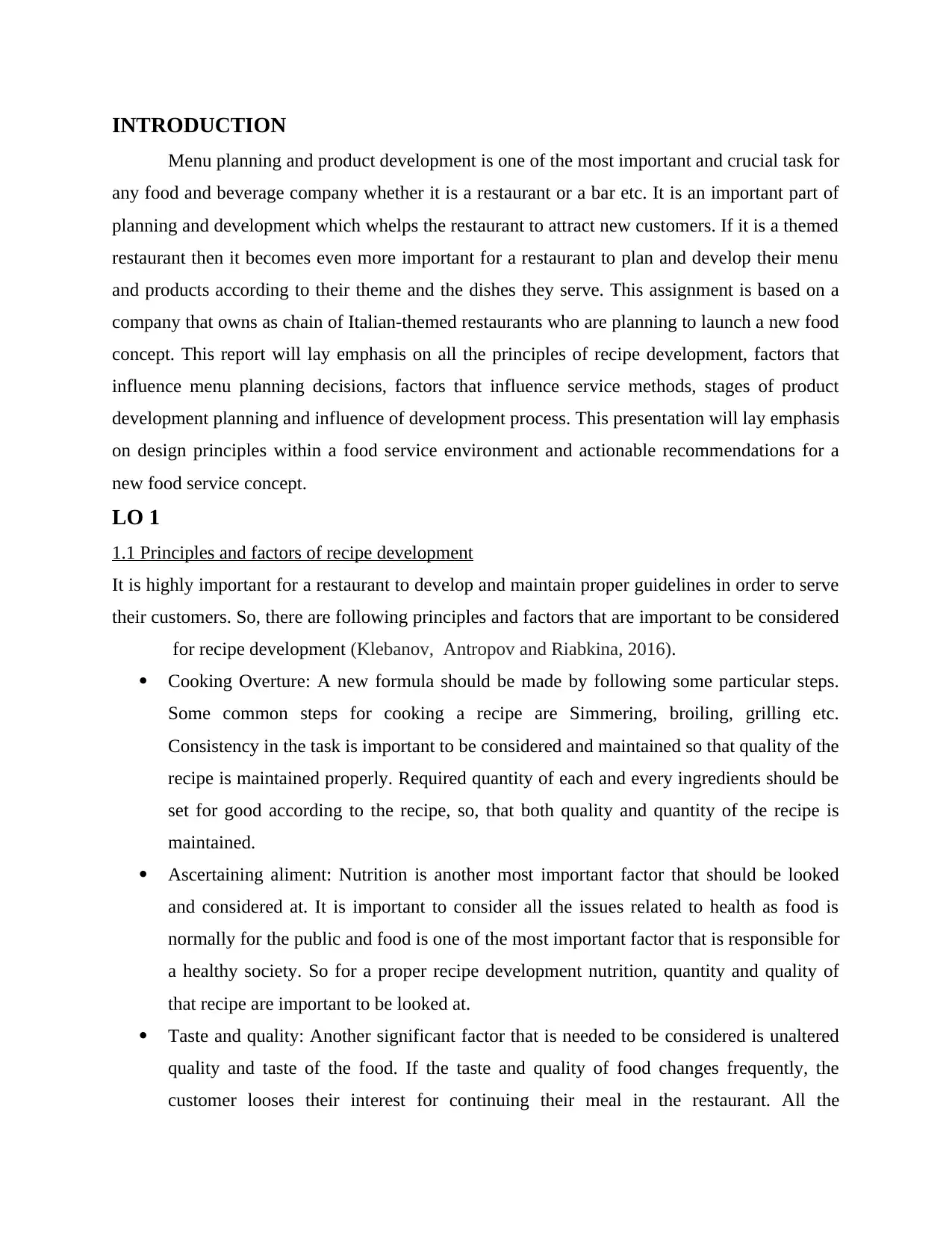
INTRODUCTION
Menu planning and product development is one of the most important and crucial task for
any food and beverage company whether it is a restaurant or a bar etc. It is an important part of
planning and development which whelps the restaurant to attract new customers. If it is a themed
restaurant then it becomes even more important for a restaurant to plan and develop their menu
and products according to their theme and the dishes they serve. This assignment is based on a
company that owns as chain of Italian-themed restaurants who are planning to launch a new food
concept. This report will lay emphasis on all the principles of recipe development, factors that
influence menu planning decisions, factors that influence service methods, stages of product
development planning and influence of development process. This presentation will lay emphasis
on design principles within a food service environment and actionable recommendations for a
new food service concept.
LO 1
1.1 Principles and factors of recipe development
It is highly important for a restaurant to develop and maintain proper guidelines in order to serve
their customers. So, there are following principles and factors that are important to be considered
for recipe development (Klebanov, Antropov and Riabkina, 2016).
Cooking Overture: A new formula should be made by following some particular steps.
Some common steps for cooking a recipe are Simmering, broiling, grilling etc.
Consistency in the task is important to be considered and maintained so that quality of the
recipe is maintained properly. Required quantity of each and every ingredients should be
set for good according to the recipe, so, that both quality and quantity of the recipe is
maintained.
Ascertaining aliment: Nutrition is another most important factor that should be looked
and considered at. It is important to consider all the issues related to health as food is
normally for the public and food is one of the most important factor that is responsible for
a healthy society. So for a proper recipe development nutrition, quantity and quality of
that recipe are important to be looked at.
Taste and quality: Another significant factor that is needed to be considered is unaltered
quality and taste of the food. If the taste and quality of food changes frequently, the
customer looses their interest for continuing their meal in the restaurant. All the
Menu planning and product development is one of the most important and crucial task for
any food and beverage company whether it is a restaurant or a bar etc. It is an important part of
planning and development which whelps the restaurant to attract new customers. If it is a themed
restaurant then it becomes even more important for a restaurant to plan and develop their menu
and products according to their theme and the dishes they serve. This assignment is based on a
company that owns as chain of Italian-themed restaurants who are planning to launch a new food
concept. This report will lay emphasis on all the principles of recipe development, factors that
influence menu planning decisions, factors that influence service methods, stages of product
development planning and influence of development process. This presentation will lay emphasis
on design principles within a food service environment and actionable recommendations for a
new food service concept.
LO 1
1.1 Principles and factors of recipe development
It is highly important for a restaurant to develop and maintain proper guidelines in order to serve
their customers. So, there are following principles and factors that are important to be considered
for recipe development (Klebanov, Antropov and Riabkina, 2016).
Cooking Overture: A new formula should be made by following some particular steps.
Some common steps for cooking a recipe are Simmering, broiling, grilling etc.
Consistency in the task is important to be considered and maintained so that quality of the
recipe is maintained properly. Required quantity of each and every ingredients should be
set for good according to the recipe, so, that both quality and quantity of the recipe is
maintained.
Ascertaining aliment: Nutrition is another most important factor that should be looked
and considered at. It is important to consider all the issues related to health as food is
normally for the public and food is one of the most important factor that is responsible for
a healthy society. So for a proper recipe development nutrition, quantity and quality of
that recipe are important to be looked at.
Taste and quality: Another significant factor that is needed to be considered is unaltered
quality and taste of the food. If the taste and quality of food changes frequently, the
customer looses their interest for continuing their meal in the restaurant. All the
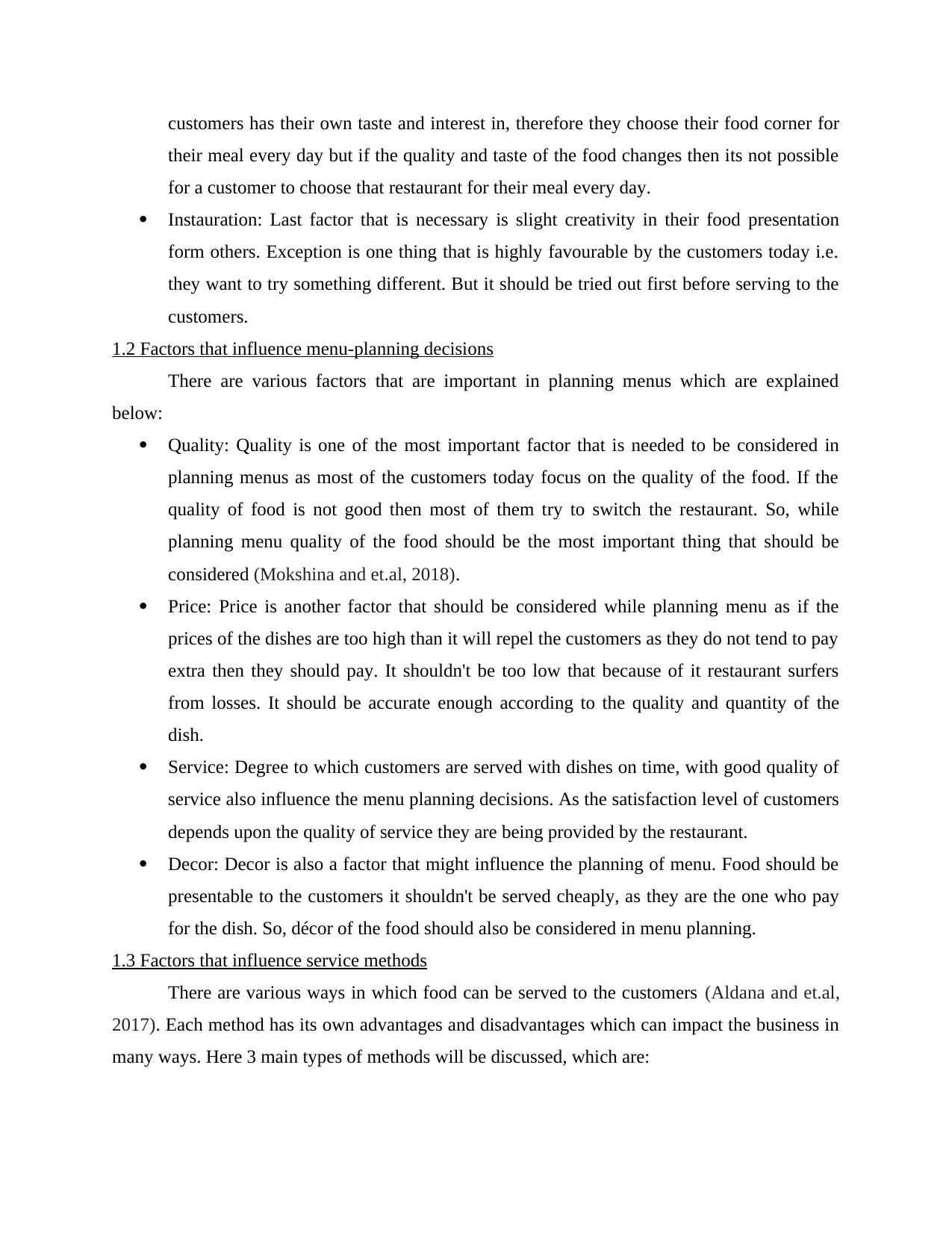
customers has their own taste and interest in, therefore they choose their food corner for
their meal every day but if the quality and taste of the food changes then its not possible
for a customer to choose that restaurant for their meal every day.
Instauration: Last factor that is necessary is slight creativity in their food presentation
form others. Exception is one thing that is highly favourable by the customers today i.e.
they want to try something different. But it should be tried out first before serving to the
customers.
1.2 Factors that influence menu-planning decisions
There are various factors that are important in planning menus which are explained
below:
Quality: Quality is one of the most important factor that is needed to be considered in
planning menus as most of the customers today focus on the quality of the food. If the
quality of food is not good then most of them try to switch the restaurant. So, while
planning menu quality of the food should be the most important thing that should be
considered (Mokshina and et.al, 2018).
Price: Price is another factor that should be considered while planning menu as if the
prices of the dishes are too high than it will repel the customers as they do not tend to pay
extra then they should pay. It shouldn't be too low that because of it restaurant surfers
from losses. It should be accurate enough according to the quality and quantity of the
dish.
Service: Degree to which customers are served with dishes on time, with good quality of
service also influence the menu planning decisions. As the satisfaction level of customers
depends upon the quality of service they are being provided by the restaurant.
Decor: Decor is also a factor that might influence the planning of menu. Food should be
presentable to the customers it shouldn't be served cheaply, as they are the one who pay
for the dish. So, décor of the food should also be considered in menu planning.
1.3 Factors that influence service methods
There are various ways in which food can be served to the customers (Aldana and et.al,
2017). Each method has its own advantages and disadvantages which can impact the business in
many ways. Here 3 main types of methods will be discussed, which are:
their meal every day but if the quality and taste of the food changes then its not possible
for a customer to choose that restaurant for their meal every day.
Instauration: Last factor that is necessary is slight creativity in their food presentation
form others. Exception is one thing that is highly favourable by the customers today i.e.
they want to try something different. But it should be tried out first before serving to the
customers.
1.2 Factors that influence menu-planning decisions
There are various factors that are important in planning menus which are explained
below:
Quality: Quality is one of the most important factor that is needed to be considered in
planning menus as most of the customers today focus on the quality of the food. If the
quality of food is not good then most of them try to switch the restaurant. So, while
planning menu quality of the food should be the most important thing that should be
considered (Mokshina and et.al, 2018).
Price: Price is another factor that should be considered while planning menu as if the
prices of the dishes are too high than it will repel the customers as they do not tend to pay
extra then they should pay. It shouldn't be too low that because of it restaurant surfers
from losses. It should be accurate enough according to the quality and quantity of the
dish.
Service: Degree to which customers are served with dishes on time, with good quality of
service also influence the menu planning decisions. As the satisfaction level of customers
depends upon the quality of service they are being provided by the restaurant.
Decor: Decor is also a factor that might influence the planning of menu. Food should be
presentable to the customers it shouldn't be served cheaply, as they are the one who pay
for the dish. So, décor of the food should also be considered in menu planning.
1.3 Factors that influence service methods
There are various ways in which food can be served to the customers (Aldana and et.al,
2017). Each method has its own advantages and disadvantages which can impact the business in
many ways. Here 3 main types of methods will be discussed, which are:
Secure Best Marks with AI Grader
Need help grading? Try our AI Grader for instant feedback on your assignments.

English Service: In this meal is put in portion on the platter by the waiter and then it is
served to the customers on trolley. All the dishes are served to the customers with the
portion of food foe each customer. However, this serving method has its own advantages
and disadvantages.
Advantages:
◦ Customers are served quickly and on time.
◦ Fine display of food on platter.
◦ Waiter gets a chance to show their skills.
◦ Waiter can serve more customers in this method as compared to other service
methods.
Disadvantages:
◦ Require special training for service.
◦ It cost more in operation which is then transferred to the customers.
◦ Dish can get cold while reaching the last customer.
French Service: It is one of the most traditional method of serving which was initially
done for serving honourable people of France.
Advantages:
◦ Plenty of food is offered.
◦ Customers get a chance to choose the amount of food they want on their platters.
◦ Portions are not predefined.
Disadvantages:
◦ This is applied on rich and expensive meals.
◦ Service is very slow and can get difficult for the staff members at the peak hours.
◦ Additional and qualified staff members are required.
Russian service: Food preparation of various foods are cooked as a whole such as turkey
etc. In Europe it appeared around 1900.
Advantages:
◦ Appearance of food is very much attractive.
◦ Chef gets a chance to show their skills.
Disadvantages:
◦ Service requires qualified staff.
served to the customers on trolley. All the dishes are served to the customers with the
portion of food foe each customer. However, this serving method has its own advantages
and disadvantages.
Advantages:
◦ Customers are served quickly and on time.
◦ Fine display of food on platter.
◦ Waiter gets a chance to show their skills.
◦ Waiter can serve more customers in this method as compared to other service
methods.
Disadvantages:
◦ Require special training for service.
◦ It cost more in operation which is then transferred to the customers.
◦ Dish can get cold while reaching the last customer.
French Service: It is one of the most traditional method of serving which was initially
done for serving honourable people of France.
Advantages:
◦ Plenty of food is offered.
◦ Customers get a chance to choose the amount of food they want on their platters.
◦ Portions are not predefined.
Disadvantages:
◦ This is applied on rich and expensive meals.
◦ Service is very slow and can get difficult for the staff members at the peak hours.
◦ Additional and qualified staff members are required.
Russian service: Food preparation of various foods are cooked as a whole such as turkey
etc. In Europe it appeared around 1900.
Advantages:
◦ Appearance of food is very much attractive.
◦ Chef gets a chance to show their skills.
Disadvantages:
◦ Service requires qualified staff.
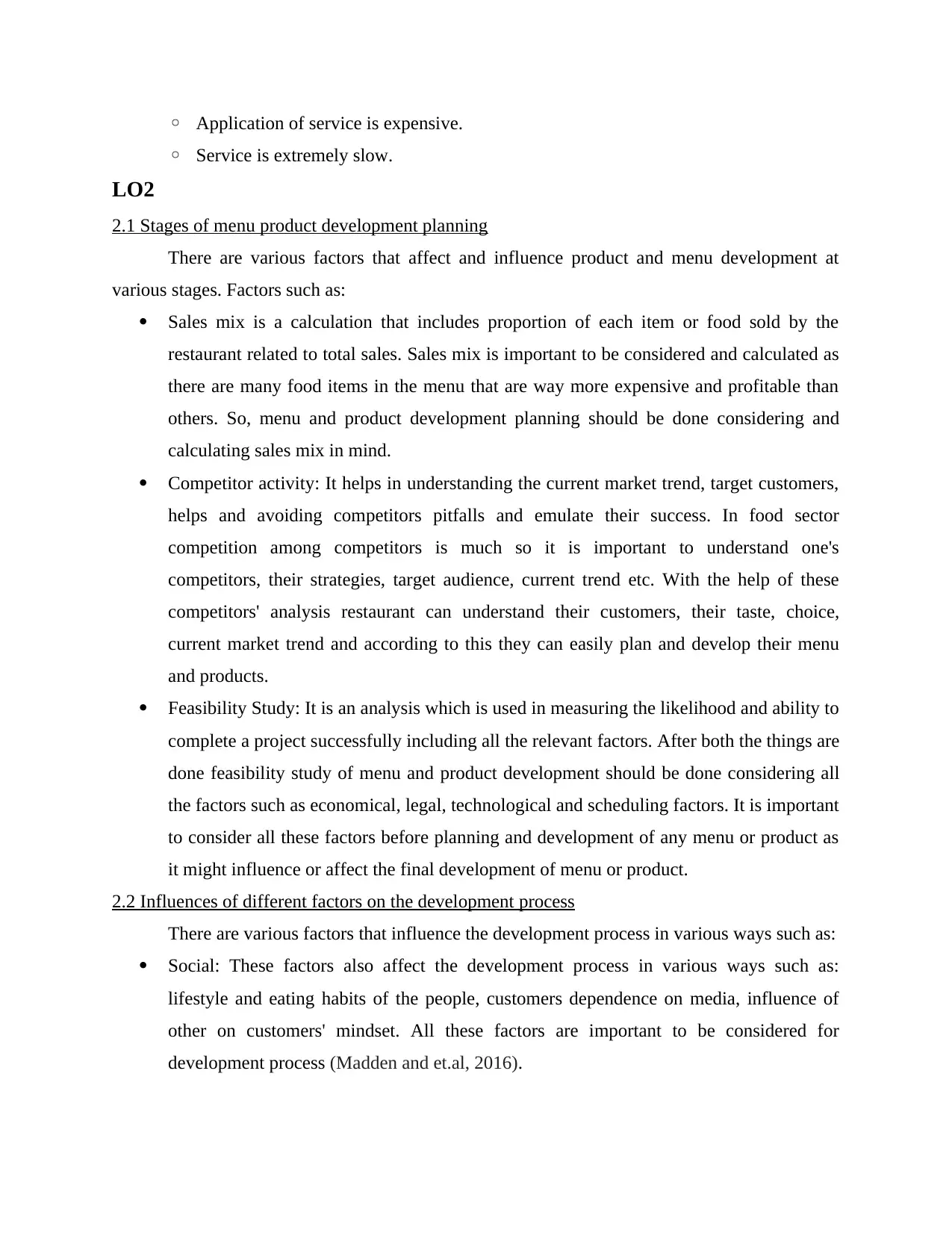
◦ Application of service is expensive.
◦ Service is extremely slow.
LO2
2.1 Stages of menu product development planning
There are various factors that affect and influence product and menu development at
various stages. Factors such as:
Sales mix is a calculation that includes proportion of each item or food sold by the
restaurant related to total sales. Sales mix is important to be considered and calculated as
there are many food items in the menu that are way more expensive and profitable than
others. So, menu and product development planning should be done considering and
calculating sales mix in mind.
Competitor activity: It helps in understanding the current market trend, target customers,
helps and avoiding competitors pitfalls and emulate their success. In food sector
competition among competitors is much so it is important to understand one's
competitors, their strategies, target audience, current trend etc. With the help of these
competitors' analysis restaurant can understand their customers, their taste, choice,
current market trend and according to this they can easily plan and develop their menu
and products.
Feasibility Study: It is an analysis which is used in measuring the likelihood and ability to
complete a project successfully including all the relevant factors. After both the things are
done feasibility study of menu and product development should be done considering all
the factors such as economical, legal, technological and scheduling factors. It is important
to consider all these factors before planning and development of any menu or product as
it might influence or affect the final development of menu or product.
2.2 Influences of different factors on the development process
There are various factors that influence the development process in various ways such as:
Social: These factors also affect the development process in various ways such as:
lifestyle and eating habits of the people, customers dependence on media, influence of
other on customers' mindset. All these factors are important to be considered for
development process (Madden and et.al, 2016).
◦ Service is extremely slow.
LO2
2.1 Stages of menu product development planning
There are various factors that affect and influence product and menu development at
various stages. Factors such as:
Sales mix is a calculation that includes proportion of each item or food sold by the
restaurant related to total sales. Sales mix is important to be considered and calculated as
there are many food items in the menu that are way more expensive and profitable than
others. So, menu and product development planning should be done considering and
calculating sales mix in mind.
Competitor activity: It helps in understanding the current market trend, target customers,
helps and avoiding competitors pitfalls and emulate their success. In food sector
competition among competitors is much so it is important to understand one's
competitors, their strategies, target audience, current trend etc. With the help of these
competitors' analysis restaurant can understand their customers, their taste, choice,
current market trend and according to this they can easily plan and develop their menu
and products.
Feasibility Study: It is an analysis which is used in measuring the likelihood and ability to
complete a project successfully including all the relevant factors. After both the things are
done feasibility study of menu and product development should be done considering all
the factors such as economical, legal, technological and scheduling factors. It is important
to consider all these factors before planning and development of any menu or product as
it might influence or affect the final development of menu or product.
2.2 Influences of different factors on the development process
There are various factors that influence the development process in various ways such as:
Social: These factors also affect the development process in various ways such as:
lifestyle and eating habits of the people, customers dependence on media, influence of
other on customers' mindset. All these factors are important to be considered for
development process (Madden and et.al, 2016).
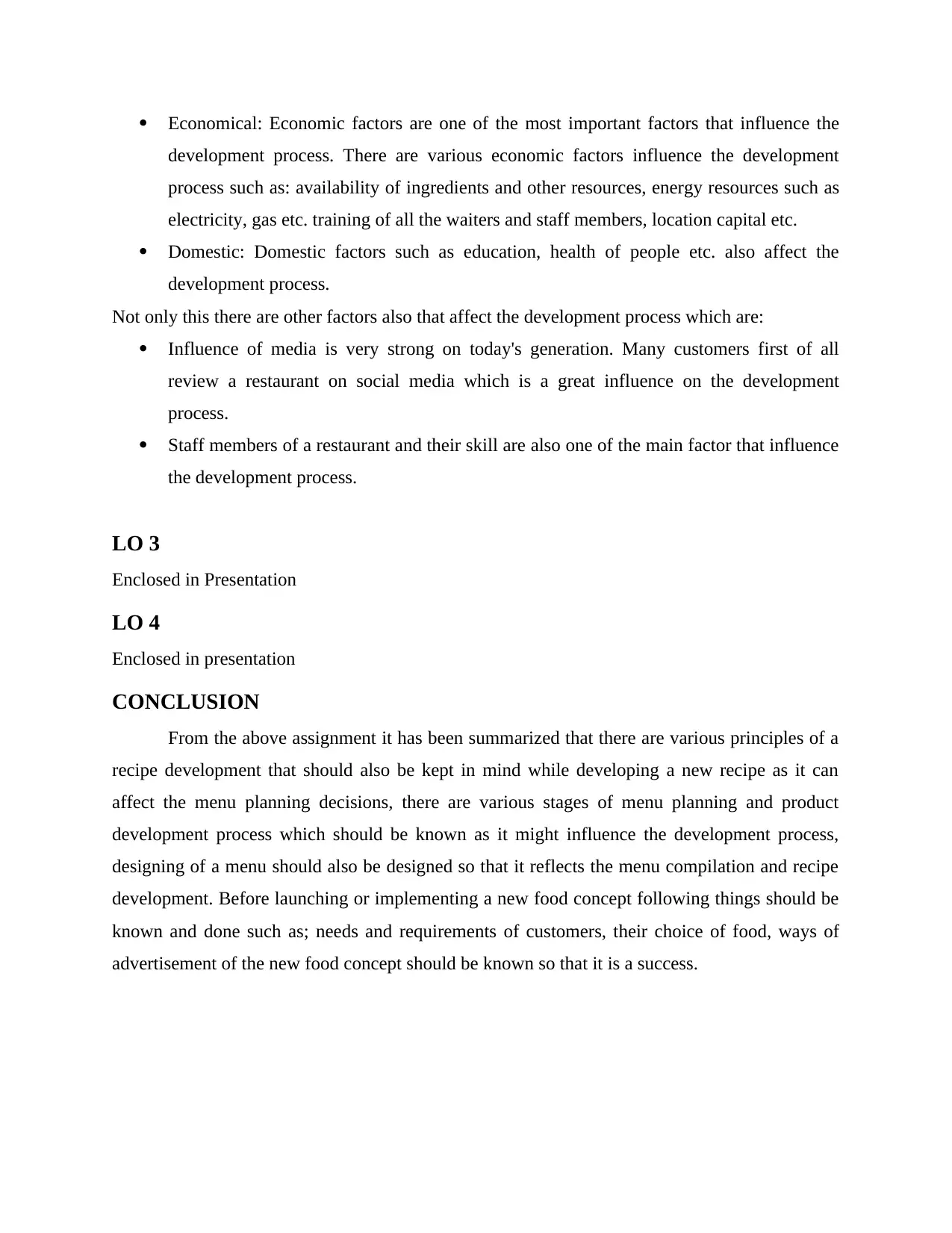
Economical: Economic factors are one of the most important factors that influence the
development process. There are various economic factors influence the development
process such as: availability of ingredients and other resources, energy resources such as
electricity, gas etc. training of all the waiters and staff members, location capital etc.
Domestic: Domestic factors such as education, health of people etc. also affect the
development process.
Not only this there are other factors also that affect the development process which are:
Influence of media is very strong on today's generation. Many customers first of all
review a restaurant on social media which is a great influence on the development
process.
Staff members of a restaurant and their skill are also one of the main factor that influence
the development process.
LO 3
Enclosed in Presentation
LO 4
Enclosed in presentation
CONCLUSION
From the above assignment it has been summarized that there are various principles of a
recipe development that should also be kept in mind while developing a new recipe as it can
affect the menu planning decisions, there are various stages of menu planning and product
development process which should be known as it might influence the development process,
designing of a menu should also be designed so that it reflects the menu compilation and recipe
development. Before launching or implementing a new food concept following things should be
known and done such as; needs and requirements of customers, their choice of food, ways of
advertisement of the new food concept should be known so that it is a success.
development process. There are various economic factors influence the development
process such as: availability of ingredients and other resources, energy resources such as
electricity, gas etc. training of all the waiters and staff members, location capital etc.
Domestic: Domestic factors such as education, health of people etc. also affect the
development process.
Not only this there are other factors also that affect the development process which are:
Influence of media is very strong on today's generation. Many customers first of all
review a restaurant on social media which is a great influence on the development
process.
Staff members of a restaurant and their skill are also one of the main factor that influence
the development process.
LO 3
Enclosed in Presentation
LO 4
Enclosed in presentation
CONCLUSION
From the above assignment it has been summarized that there are various principles of a
recipe development that should also be kept in mind while developing a new recipe as it can
affect the menu planning decisions, there are various stages of menu planning and product
development process which should be known as it might influence the development process,
designing of a menu should also be designed so that it reflects the menu compilation and recipe
development. Before launching or implementing a new food concept following things should be
known and done such as; needs and requirements of customers, their choice of food, ways of
advertisement of the new food concept should be known so that it is a success.
Paraphrase This Document
Need a fresh take? Get an instant paraphrase of this document with our AI Paraphraser
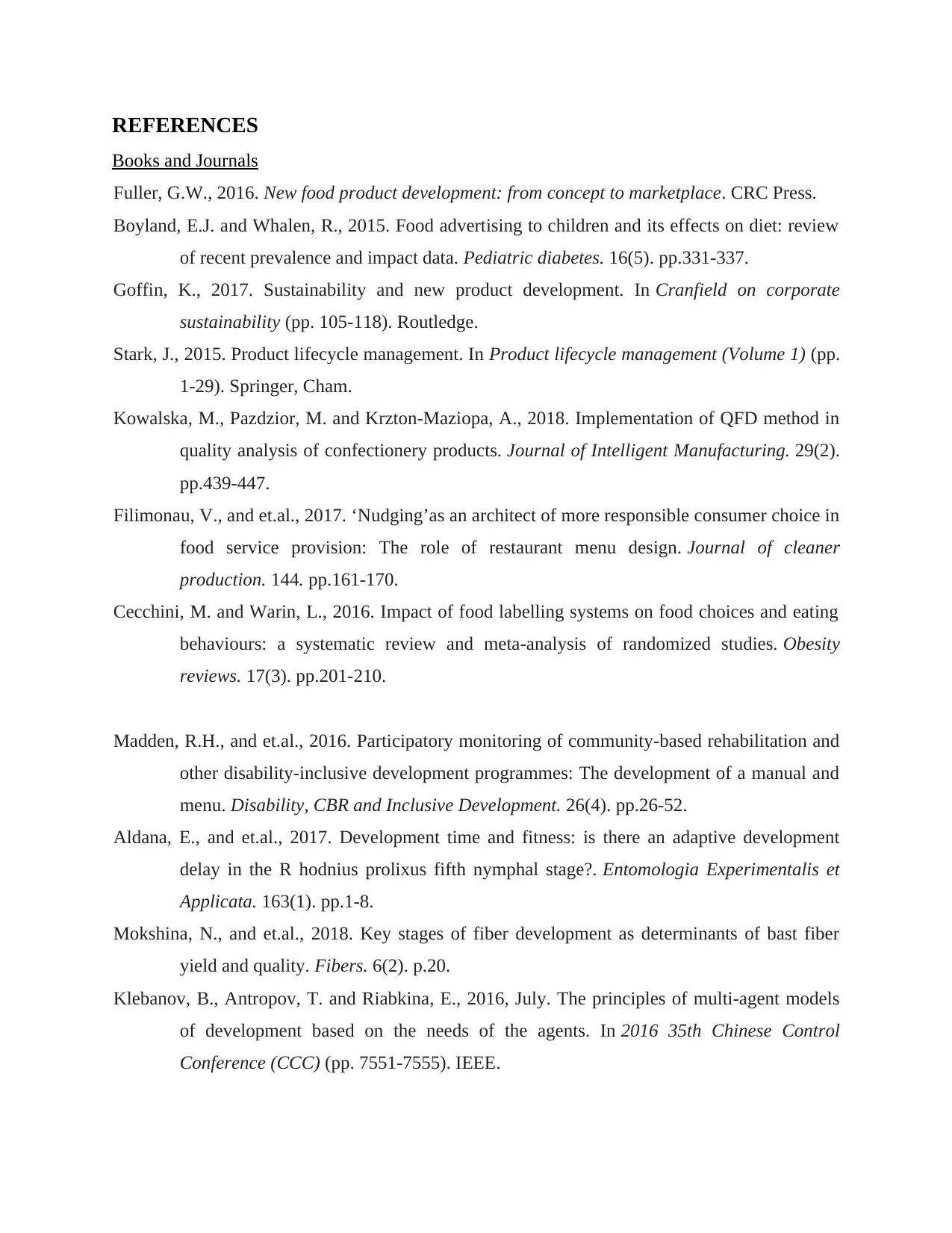
REFERENCES
Books and Journals
Fuller, G.W., 2016. New food product development: from concept to marketplace. CRC Press.
Boyland, E.J. and Whalen, R., 2015. Food advertising to children and its effects on diet: review
of recent prevalence and impact data. Pediatric diabetes. 16(5). pp.331-337.
Goffin, K., 2017. Sustainability and new product development. In Cranfield on corporate
sustainability (pp. 105-118). Routledge.
Stark, J., 2015. Product lifecycle management. In Product lifecycle management (Volume 1) (pp.
1-29). Springer, Cham.
Kowalska, M., Pazdzior, M. and Krzton-Maziopa, A., 2018. Implementation of QFD method in
quality analysis of confectionery products. Journal of Intelligent Manufacturing. 29(2).
pp.439-447.
Filimonau, V., and et.al., 2017. ‘Nudging’as an architect of more responsible consumer choice in
food service provision: The role of restaurant menu design. Journal of cleaner
production. 144. pp.161-170.
Cecchini, M. and Warin, L., 2016. Impact of food labelling systems on food choices and eating
behaviours: a systematic review and meta‐analysis of randomized studies. Obesity
reviews. 17(3). pp.201-210.
Madden, R.H., and et.al., 2016. Participatory monitoring of community-based rehabilitation and
other disability-inclusive development programmes: The development of a manual and
menu. Disability, CBR and Inclusive Development. 26(4). pp.26-52.
Aldana, E., and et.al., 2017. Development time and fitness: is there an adaptive development
delay in the R hodnius prolixus fifth nymphal stage?. Entomologia Experimentalis et
Applicata. 163(1). pp.1-8.
Mokshina, N., and et.al., 2018. Key stages of fiber development as determinants of bast fiber
yield and quality. Fibers. 6(2). p.20.
Klebanov, B., Antropov, T. and Riabkina, E., 2016, July. The principles of multi-agent models
of development based on the needs of the agents. In 2016 35th Chinese Control
Conference (CCC) (pp. 7551-7555). IEEE.
Books and Journals
Fuller, G.W., 2016. New food product development: from concept to marketplace. CRC Press.
Boyland, E.J. and Whalen, R., 2015. Food advertising to children and its effects on diet: review
of recent prevalence and impact data. Pediatric diabetes. 16(5). pp.331-337.
Goffin, K., 2017. Sustainability and new product development. In Cranfield on corporate
sustainability (pp. 105-118). Routledge.
Stark, J., 2015. Product lifecycle management. In Product lifecycle management (Volume 1) (pp.
1-29). Springer, Cham.
Kowalska, M., Pazdzior, M. and Krzton-Maziopa, A., 2018. Implementation of QFD method in
quality analysis of confectionery products. Journal of Intelligent Manufacturing. 29(2).
pp.439-447.
Filimonau, V., and et.al., 2017. ‘Nudging’as an architect of more responsible consumer choice in
food service provision: The role of restaurant menu design. Journal of cleaner
production. 144. pp.161-170.
Cecchini, M. and Warin, L., 2016. Impact of food labelling systems on food choices and eating
behaviours: a systematic review and meta‐analysis of randomized studies. Obesity
reviews. 17(3). pp.201-210.
Madden, R.H., and et.al., 2016. Participatory monitoring of community-based rehabilitation and
other disability-inclusive development programmes: The development of a manual and
menu. Disability, CBR and Inclusive Development. 26(4). pp.26-52.
Aldana, E., and et.al., 2017. Development time and fitness: is there an adaptive development
delay in the R hodnius prolixus fifth nymphal stage?. Entomologia Experimentalis et
Applicata. 163(1). pp.1-8.
Mokshina, N., and et.al., 2018. Key stages of fiber development as determinants of bast fiber
yield and quality. Fibers. 6(2). p.20.
Klebanov, B., Antropov, T. and Riabkina, E., 2016, July. The principles of multi-agent models
of development based on the needs of the agents. In 2016 35th Chinese Control
Conference (CCC) (pp. 7551-7555). IEEE.
1 out of 8
Related Documents
Your All-in-One AI-Powered Toolkit for Academic Success.
+13062052269
info@desklib.com
Available 24*7 on WhatsApp / Email
![[object Object]](/_next/static/media/star-bottom.7253800d.svg)
Unlock your academic potential
© 2024 | Zucol Services PVT LTD | All rights reserved.





